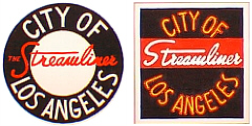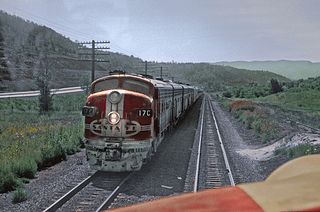
A streamliner is a vehicle incorporating streamlining in a shape providing reduced air resistance. The term is applied to high-speed railway trainsets of the 1930s to 1950s, and to their successor "bullet trains". Less commonly, the term is applied to fully faired upright and recumbent bicycles. As part of the Streamline Moderne trend, the term was applied to passenger cars, trucks, and other types of light-, medium-, or heavy-duty vehicles, but now vehicle streamlining is so prevalent that it is not an outstanding characteristic. In land speed racing, it is a term applied to the long, slender, custom built, high-speed vehicles with enclosed wheels.

The Broadway Limited was a passenger train operated by the Pennsylvania Railroad (PRR) between New York City and Chicago. It operated from 1912 to 1995. It was the Pennsylvania's premier train, competing directly with the New York Central Railroad's 20th Century Limited. The Broadway Limited continued operating after the formation of Penn Central (PC) in February 1968, one of the few long-distance trains to do so. PC conveyed the train to Amtrak in 1971, who operated it until 1995. The train's name referred not to Broadway in Manhattan, but rather to the "broad way" of PRR's four-track right-of-way along the majority of its route.

The Super Chief was one of the named passenger trains and the flagship of the Atchison, Topeka and Santa Fe Railway. The then-modern streamliner was touted in its heyday as "The Train of the Stars" because it often carried celebrities between Chicago, Illinois, and Los Angeles, California.

The City of Denver was a streamlined passenger train operated by the Union Pacific Railroad between Chicago, Illinois, and Denver, Colorado. It operated between 1936 and 1971. From 1936–1955 the Chicago and North Western Railway handled the train east of Omaha, Nebraska; the Chicago, Milwaukee, St. Paul and Pacific Railroad handled it thereafter. The train was the fastest long-distance train in the United States when it debuted in 1936, covering 1,048 miles (1,687 km) in 16 hours. For almost its entire career its principal competitor was the Chicago, Burlington and Quincy Railroad's Denver Zephyr. When Amtrak assumed operation of most intercity trains in the United States in 1971, it discontinued the City of Denver, preferring to use the Burlington's route between Chicago and Denver.

The City of Los Angeles was a streamlined passenger train between Chicago, Illinois, and Los Angeles, California via Omaha, Nebraska, and Ogden, Utah. Between Omaha and Los Angeles it ran on the Union Pacific Railroad; east of Omaha it ran on the Chicago and North Western Railway until October 1955 and on the Milwaukee Road thereafter. The train had number 103 westbound and number 104 eastbound.

The Chief was a long-distance named passenger train of the Atchison, Topeka and Santa Fe Railway that ran between Chicago, Illinois and Los Angeles, California. The Santa Fe initiated the Chief in 1926 to supplement the California Limited. In 1936 the Super Chief was introduced, soon eclipsing the Chief as the standard bearer of the Santa Fe. The Chief was discontinued in 1968 due to high operating costs, competition from airlines, and the loss of Postal Office contracts.

The Denver Zephyr was a streamlined passenger train operated by the Chicago, Burlington and Quincy Railroad between Chicago, Illinois, and Denver, Colorado. In peak years it ran to Colorado Springs. It operated from 1936 to 1973. The Denver Zephyr continued operating after the Burlington Northern Railroad merger in 1970. BN conveyed the train to Amtrak in 1971; Amtrak merged it with the Denver–Oakland City of San Francisco to form the San Francisco Zephyr and dropped the "Denver" name in 1973.

The Golden State was a named passenger train between Chicago and Los Angeles from 1902–1968 on the Chicago, Rock Island and Pacific Railroad and the Southern Pacific Company (SP) and predecessors. It was named for California, the “Golden State”.

The City of San Francisco was a streamlined through passenger train which ran from 1936 to 1971 on the Overland Route between Chicago, Illinois and Oakland, California, with a ferry connection on to San Francisco. It was owned and operated jointly by the Chicago and North Western Railway (1936–55), Chicago, Milwaukee, St. Paul and Pacific Railroad (1955–71), the Union Pacific Railroad, and the Southern Pacific Railroad. It provided premium extra fare service from Chicago to San Francisco when introduced in 1936 with a running time of 39 hours and 45 minutes each way.
The Choctaw Rocket was a named passenger train operated by the Chicago, Rock Island and Pacific Railroad between Memphis, Tennessee, Little Rock, Oklahoma City, and Amarillo. Initially designated as train No. 51 (westbound) and train No. 52 (eastbound), it was the first diesel powered streamliner to operate out of Memphis, Tennessee, as well as the first streamliner service in the state of Arkansas.

The Golden Rocket was a proposed named passenger train of the Rock Island (CRIP) and Southern Pacific (SP) railroads. Planned in the late 1940s, Southern Pacific eventually pulled out of the agreement and service never commenced.

The Lark was an overnight passenger train of the Southern Pacific Company on the 470-mile (760 km) run between San Francisco and Los Angeles. It became a streamliner in 1941 and was discontinued on April 8, 1968. The Lark ran along the same route as the Coast Daylight and was often pulled by a locomotive wearing the famous Daylight paint scheme of orange, red, and black.

The Rocky Mountain Rocket was a streamlined passenger train of the Chicago, Rock Island and Pacific Railroad. Rock Island's train numbers 7 and 8 ran between Chicago's LaSalle Street Station and Denver's Union Station and Colorado Springs, Colorado. The Rocky Mountain Rocket ran from 1939 to 1966; the train was discontinued prior to the creation of Amtrak in 1971.

The Museum of the American Railroad, formerly known as the Age of Steam Railroad Museum, is a railroad museum in Frisco, Texas. The museum has more than 70 pieces of steam, diesel, passenger, and freight railroad equipment sitting on 15 acres making it one of the largest historic rail collections in the US. Guests may walk through some of the equipment on guided tours. Still under construction, it is one of the Nation's premier railroad museums.

The Texas Zephyr was a named passenger train operated by the Colorado & Southern Railway and the Fort Worth & Denver Railway. The train was originally designated number 1 southbound, and number 2 northbound.
The Twin Star Rocket was a passenger train operated by the Chicago, Rock Island and Pacific Railroad. Introduced on January 14, 1945, it was the only new streamlined train permitted to enter service in World War II by the U.S. government. The new train became the second longest north–south train itinerary under the management of a single railroad in the United States with its northern terminal at the Milwaukee Road’s Minneapolis depot and southern terminal 1,363 miles (2,194 km) away at Houston, Texas. The name of the new streamlined train was derived from its terminal states—Texas being known as the Lone Star State and Minnesota as the North Star State. Additionally, the name references Minneapolis being one of the Twin Cities and Houston's aerospace industry and culture.

The Winnipeg Limited was an overnight named passenger train operated by the Great Northern Railway 457 miles (735 km) between St. Paul-Minneapolis and Winnipeg, Manitoba. It competed on the route with the overnight Winnipeger of the Minneapolis, St. Paul and Sault Ste. Marie Railway, and the Northern Pacific Railway's unnamed daytime passenger train. The service was truncated to run between Manitoba and Grand Forks after February 2, 1970.

The Los Angeles Limited was a named passenger train in the United States. It was operated by the Union Pacific Railroad from 1905 to 1954.

The Chicago, Rock Island and Pacific Railroad Rockets were lightweight, streamlined diesel-electric passenger trains built by the Budd Company. These six trains were the first streamlined equipment purchased by the Rock Island, as well as being its first diesel-powered passenger trains. Four of the trains consisted of three cars each, the other two each had four cars.
The General was the Pennsylvania Railroad's (PRR) number two train between New York City and Chicago. Only marginally slower than the Broadway Limited, it had no extra fare. For a time before World War II, the train carried more passengers than the Broadway Limited and had been stealing passengers from the New York Central Railroad's 20th Century Limited.



















